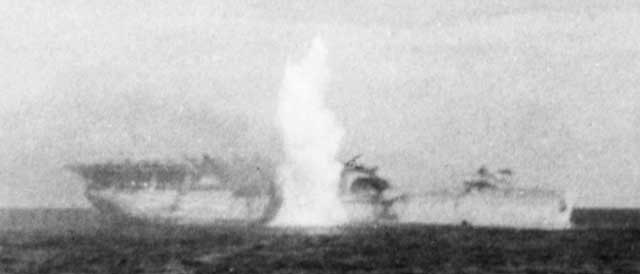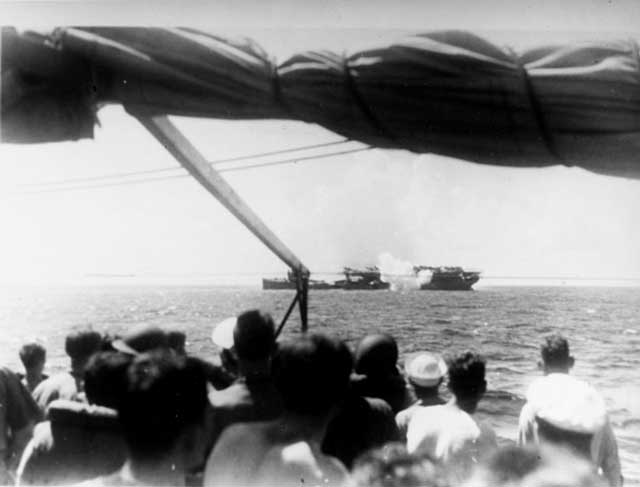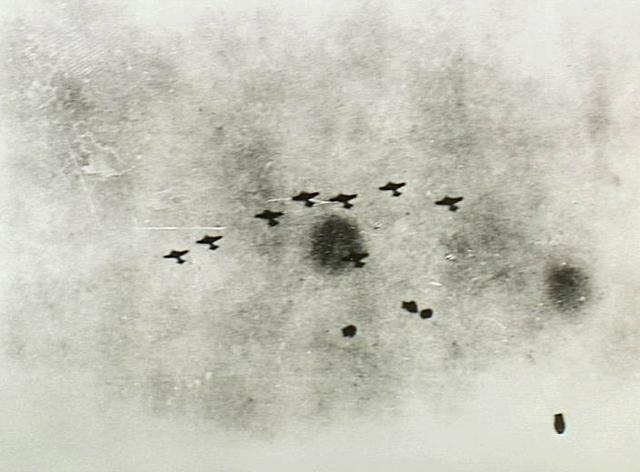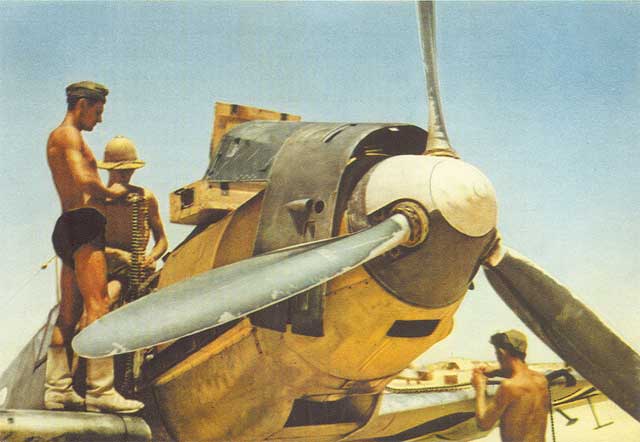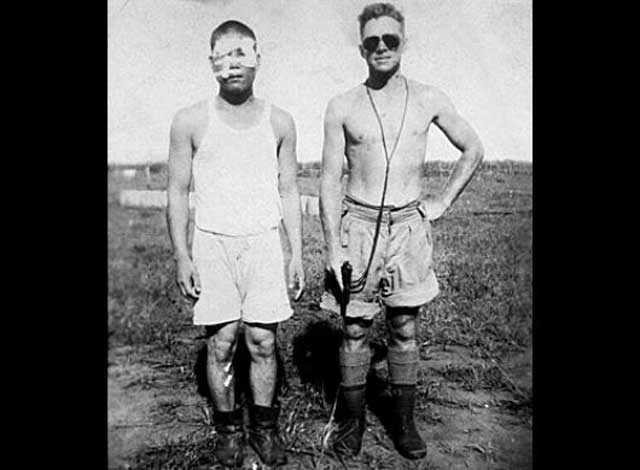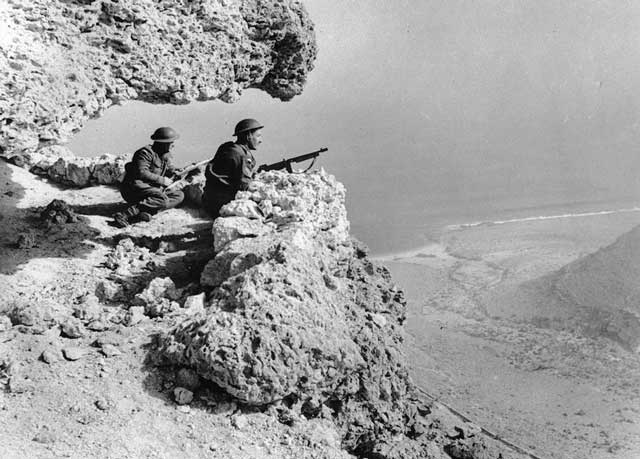Sunday 15 February 1942
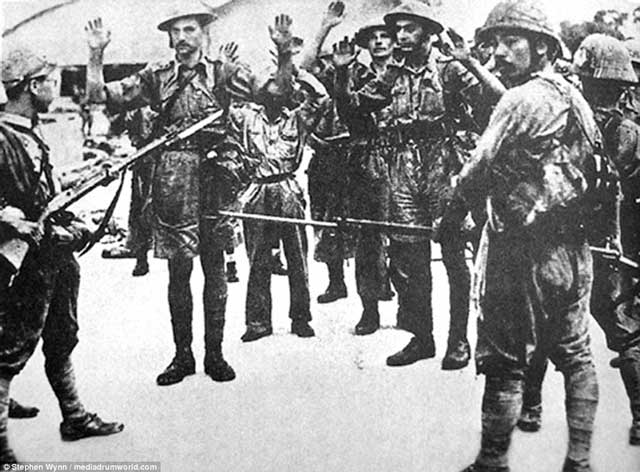 |
| In Singapore, British troops surrender to the Japanese, 15 February 1942 (Daily Mail). |
Battle of the Pacific: At about 19:00 local time on
15 February 1942, the British in Singapore surrender to the Japanese 25th Army. Hostilities are agreed to cease at 20:30. Local commander General Arthur Percival cites shortages of water, food, oil, and ammunition. According to contemporaneous estimates in London, approximately 55,000-60,000 British and Imperial Troops (including many Indian and Australian formations) go into captivity (later estimates are higher, at about 85,000). Many small ships are captured in port, including 296-ton Siushan, 65-ton Mersing, and a requisitioned yacht, Silvia. The Japanese also come into possession of a few larger ships, including 254-ton freighter Rhu. This begins a long and oppressive Japanese occupation of Singapore.
 |
| Putting a brave face on events in Singapore, the media notes the "desperate attempt to break the stern spirit of the defenders." The People, Sunday 15 February 1942. |
Many feel (on 15 February 1942 and later) that Percival mishandled the defense and surrendered without having upheld the honor of the British Army. The British Army never forgives Percival, and he is excluded from the final Japanese surrender ceremony aboard USS Missouri on 2 September 1945 (even though US General Wainwright, the loser at Bataan, the Philippines, pointedly is given a position of honor). ABDA Commander General Wavell, however, in a classified report (only released in 1992) blames poor discipline among the defending Australian troops - a view that is not widely shared after the fact but may influence future British decisions. Many observers place the true blame on poor British Army and Navy strategy that emanates from Whitehall.
 |
| General Percival (right) leads the surrender parley on 15 February 1942 (Daily Mail). |
In Burma, British Brigadier Sir John Smyth's 17th Infantry Division of the British Indian Army at Bilin River holds its ground against a determined Japanese attack. This is the first combat for the 17th, but the soldiers fight well. The Japanese 55th Division, however, sends units around the British strongpoints in an attempt to cut the British line of communications. The British 46th Brigade abandons Thaton. Brigadier Smyth is winning his defensive struggle but worries that his unit may be completely destroyed if his supply route is cut off. He resolves to hang on to his fortified position for another day.
 |
| "Java Sea. 15 February 1942. Bomb spray obscures the British cruiser HMS Exeter, as Exeter and the Australian cruiser, HMAS Hobart, manoeuver during a Japanese air attack. Exeter survived this attack to be later sunk in the Java Sea on 1 March 1942 by a torpedo from the Japanese destroyer, Inazuma. HMS Encounter and USS Pope were with the Exeter, and all three ships sunk off the southern coast of Borneo. (Donor J. King)" Australian War Memorial P02620.007. |
Today is decisive in the defense of Sumatra. Early in the day, the ABDA naval force, composed of five cruisers HNLMS De Ruyter, HNLMS Java, HNLMS Tromp, HMS Exeter, HMAS Hobart) and ten destroyers under the command of Admiral Karel Doorman, attempt to disrupt a Japanese invasion force off Palembang. However, after Japanese land-based planes and bombers from aircraft carrier Ryujo attack his force, Doorman withdraws to the south of Sumatra. In the afternoon, the Allies begin withdrawing all air units from southern Sumatra to Java and other personnel by sea to Java and India. The Japanese invasion fleet, under fierce air attack from Palembang II airdrome, enters the mouth of the Musi River and lands its invasion force. The Japanese capture Palembang and its precious refinery, while the British and Dutch defenders withdraw to the west coast for eventual evacuation to Java.
 |
| General Yamashita at the surrender of the British garrison of Singapore on 15 February 1942. |
There are many shipping losses near Singapore and Palembang. The British and Dutch scuttle Dutch patrol boats 217-ton Jerantut and 207-ton Klias before they leave Palembang. Japanese ships sink 191-ton tug Yin Ping about 20 miles off Muntok, with 50 deaths and 25 survivors, as it flees Palembang. Also off Muntok, a Japanese cruiser captures Auxiliary patrol boat Dymas, which departed Singapore on the 13th, and everyone aboard becomes a prisoner. Off Banka, Japanese gunfire sinks auxiliary anti-submarine ship Mata Hari, with the crew taken prisoner.
 |
| The Sunday Times notes the "stubbornly maintained" defense at Singapore. February 15, 1942 edition of The Sunday Times. Via NewspaperSG. |
The Allies have not given up on the Netherlands East Indies. Australian Army 7th Division from the Middle East arrives aboard liner SS Orcades at Oosthaven in southern Sumatra. However, it is redirected to Batavia after urgent pleading to General Wavell by Lieutenant General John Lavarack, General Officer Commanding 1st Australian Army. A US Navy convoy sails today from Port Darwin for Koepang, Timor, Netherlands East Indies. Their mission is to defend the only military airfield on Timor, Penfoie airdrome, which serves as an important transit point to Java. Both sides are building up forces in the area, but the Japanese have the initiative and the naval and air power that is vital in this region.
In Bataan, the Philippines, Japanese troops withdraw out of a salient they have driven into the US Army I Corps lines in the western half of the Main Line of Resistance (MLR). There is a small Japanese attack on the eastern half of the Bataan Peninsula in the II Corps sector which is designed to distract the Allies and aid in this evacuation. The Allies have been extremely successful in recent days at eliminating Japanese pockets behind the MLR. This has allowed them to focus more forces on the MLR. However, the Japanese on the other side of the MLR are biding their time, building up their forces and waiting for the right moment to unleash a set-piece offensive.
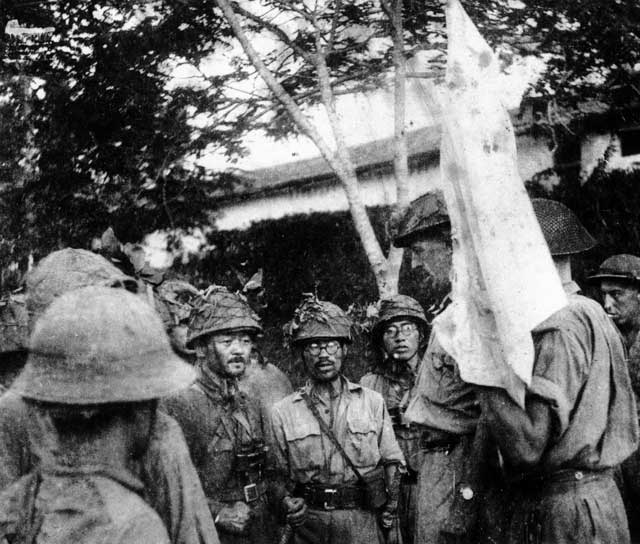 |
| The British surrender Singapore on 15 February 1942. Lieutenant-General Arthur Percival the British commander, is the tall figure just behind the white flag surrounded by Japanese soldiers. |
Martin Clemens, His Majesty's Commissioner for Guadalcanal and Coastwatcher for the Royal Australian Navy's Islands Coastwatching Service, takes up his post on Guadalcanal. His role is to report anything relevant to the war over his radio. Clemens becomes the unofficial British ruler of Guadalcanal for the time being, acting as a judge for tribal disputes and maintaining the British presence in an ostentatious way.
Japanese submarine HIJMS I-65 torpedoes and sinks 4681-ton Dutch freighter Johanne Justesen off southwest India. There are one death and 58 survivors.
 |
| A captured Soviet T-50 tank, very rare, in Finnish service, 15 February 1942 (SA-Kuva). |
Eastern Front: The Red Army continues its push south of Lake Ilmen when II Guards Rifle Corps makes contact with elements of Third Shock Army northeast of Kholm. The Soviet forces have slid between the large German garrisons at Staraya Russa and Demyansk and between Demyansk and Kholm to meet between Demyansk and Kholm. These are all considered major strong points by the Wehrmacht and anchors of the line, but the Germans don't particularly care about surrounding forests and fields. These Red Army advances have resulted in two German pockets forming, one at Demyansk and the other at Kholm slightly to the southwest. This meeting is of little significance because both German pockets already are surrounded and the Germans are not interested in defending the ground in between them. German II Corps under Generalleutnant Graf Walter von Brockdorff-Ahlefeldt at Demyansk has almost 100,000 with him and thus can hold out for some time as long as he is adequately supplied. A Luftwaffe airlift which began on 12 February is bringing the forces in the Demyansk Pocket just enough to keep from starving and being overrun, but not much more.
 |
| British Royal Navy anti-submarine vessel HMS Mata Hari, sunk at Bangka, Netherlands East Indies on 15 February 1942. |
European Air Operations: The British Air Ministry clarifies its Area Bombing Directive of 14 February 1942 after being requested to do so by Chief of the Air Staff Charles Portal. Deputy Chief of Air Staff Air Vice Marshal Norman Bottomley who had drafted the Area Bombing Directive, states:
ref the new bombing directive: I suppose it is clear the aiming points will be the built-up areas, and not, for instance, the dockyards or aircraft factories where these are mentioned in Appendix A. This must be made quite clear if it is not already understood.
This clarification makes clear that bombing efforts henceforth are, in the absence of specified targets, to be directed at the hearts of civilian population centers.
The Luftwaffe continues its raids against British shipping, bombing and damaging 489-ton British coaster Empire Head about 11 nautical miles (20 km) east of Hartlepool. It proceeds to Middlesbrough for repairs.
RAF Bomber Command sends 20 Whitley and 6 Halifax bombers against the U-boat base of St. Nazaire. The conditions are cloudy, and only 9 of the bomber crews even attempt to bomb the target. There are no losses until the bombers return to England to land and three are lost due to the poor weather.
 |
| Greek freighter Meropi, sunk on 15 February 1942. |
Battle of the Atlantic: U-432 (Kptlt. Heinz-Otto Schultze), on its fourth patrol out of La Pallice, torpedoes and sinks 5152-ton Brazilian freighter Buarque about 30 miles (48 km) southwest of Cape Henry, Virginia. There are 84 survivors and one death when a Portuguese passenger dies of a heart attack. The survivors are picked up quickly by USCGC Calypso (WPC 104) and are in Norfolk by the 17th.
U-98 (Kptlt. Robert Gysae), on its sixth patrol out of St. Nazaire, torpedoes and sinks 5298-ton freighter Biela southwest of Newfoundland. The freighter is part of Convoy ON-62. All 50 men on board perish.
U-566 (Kptlt. Dietrich Borchert), on its fourth patrol out of Lorient, torpedoes and sinks 4181-ton Greek freighter Meropi south of Nova Scotia. Meropi is part of Convoy ON-62 but is a straggler. There are 24 dead and 15 survivors.
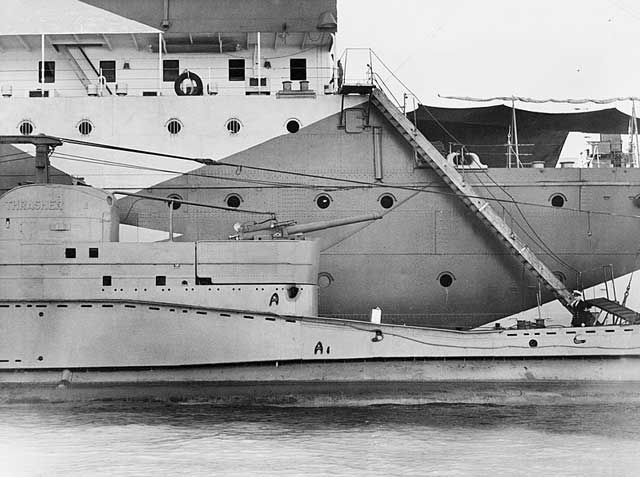 |
| HMS Thrasher on its return to port after sustaining bomb damage in the Mediterranean. The letters indicate damage. 15 or 16 February 1942. © IWM (A 8711). |
Battle of the Mediterranean: With both sides building up their forces in Libya, all of the action is at sea. U-81 reports attacking a Royal Navy light cruiser but missing. Royal Navy motor launch ML-169 catches fire and blows up at Gibraltar when the starts it, with four deaths.
 |
| Lieutenant Adnan Bin Saidi, who perished at Singapore on 15 February 1942. |
War Crimes: At Bukit Chandu ("Opium Hill") in Pasir Panjang, Second Lieutenant Adnan Bin Saidi, commander of C Company of the Malay Regiment of the 1st Malay Brigade, mounts a ferocious defense in the British last stand in front of Singapore City. He orders his troops to fight to the last man. During the fighting, he sees through a Japanese trick of disguising Japanese soldiers in British Indian uniforms in an attempt to infiltrate his positions. The reason he spots this is the Japanese march in the wrong style. Adnan has his men open fire at close range, killing many disguised Japanese soldiers. Finally, Adnan, wounded, is forced to surrender. The Japanese beat Adnan, tie him to a tree, and bayonet him to death. Adnan Saidi is considered a war hero in Singapore and Malaysia.
US/Canadian Relations: US President Franklin Roosevelt makes a radio broadcast directed specifically to Canadians. In he, he praises the country, saying:
Yours are the achievements of a great nation. They require no praise from me-but they get that praise from me nevertheless. I understate the case when I say that we, in this country, contemplating what you have done, and the spirit in which you have done it, are proud to be your neighbors.
This is part of a very calculated United States wartime effort to establish and maintain the best possible relations with its neighbors in North and South America. It is an extension of FDR's "Good Neighbor" policy that he began upon his assumption of office in 1933.
 |
| Lieutenant-General Arthur Percival, the British commander in Singapore (Daily Mail). |
British Homefront: Prime Minister Winston Churchill
broadcasts to Great Britain, Australia, New Zealand, and other parts of the British Commonwealth about the state of the war and the alliance with the United States and the Soviet Union. Speaking at night, he breaks the news of the fall of Singapore, which comes as a great shock to many people who have become accustomed to hearing good news out of "Fortress Singapore." Churchill notes that "Three-quarters of the human race are now moving with us," adding, "The whole future of mankind may depend upon our actions and upon our conduct."
American Homefront: The United States Department of Justice technically begins enforcing "Category A" areas. These are locations in Arizona, California, Oregon, and Washington which now are prohibited to enemy aliens. Entire cities in Oregon and Washington are included, but only certain counties in California (including Los Angeles County). However, there remains great disagreement within the higher reaches of the United States government as to how to implement these bans, including who is covered by the bans and what personnel will enforce them. For the time being, the bans are not enforced. Everyone, however, expects a final decision shortly.
 |
| Lobby card for "To Be Or Not To Be" (1942). |
Carole Lombard's final film, "To Be or Not to Be," premieres in Los Angeles (it goes into general release in Los Angeles on 19 February and wide release on 6 March 1942). A United Artist film directed by Ernst Lubitsch and also starring Jack Benny, "To Be or Not to Be" revolves around actors in Occupied Europe who deceive the German occupiers. The film generally is considered to be a comedy classic and led to a popular remake by Mel Brooks. The film is somewhat controversial because it is a light-hearted look at people in Poland under German oppression, somewhat similar to the situation portrayed twenty years later in "Hogan's Heroes."
Future History: Sherry D. Jackson is born in Wendell, Gooding County, Idaho. She becomes an actress who appears as one of the children in the 1950s "Ma and Pa Kettle" movies. In 1953, she is cast as the oldest daughter in "The Danny Thomas Show" (aka "Make Room For Daddy"), which runs for five years. She becomes a guest star in numerous classic 1960s and 1970s television series, including "My Three Sons," "Star Trek," and "Batman." Sherry Jackson is retired as of 2019.
Glyn Thomas Johns is born in Epsom, Surrey, England. He becomes one of the great sound engineers of the rock era. After learning his craft at IBC Studios in Portland Place, London, Johns becomes famous for his work on The Beatles' "Get Back" sessions in early 1969. Johns records the songs that become the "Let It Be" album in 1970 before they are turned over to Phil Spector for refinement. He then goes on to work with The Who, Eagles, Led Zeppelin, and many, many other famous acts as an engineer and sometimes producer. Johns develops what becomes known as the "Glyn Johns Method" for recording drums. On 14 April 2012, Johns is inducted into the Rock and Roll Hall of Fame in Cleveland. As of 2021, Glyn Johns still works with top acts such as Eric Clapton.
 |
| Black Mask Vol XXIV, No 10, February 1942 [Volume 24, Number X]. |
February 1942February 1, 1942: The US Navy Strikes BackFebruary 2, 1942: Germans Recovering in RussiaFebruary 3, 1942: Japanese Shell and Bomb SingaporeFebruary 4, 1942: Battle of Makassar StraitFebruary 5, 1942: Empress of Asia SunkFebruary 6, 1942: The Christmas Island BodyFebruary 7, 1942: The Double-V CampaignFebruary 8, 1942: Japan Invades SingaporeFebruary 9, 1942: French Liner Normandie CapsizesFebruary 10, 1942: US Car Production EndsFebruary 11, 1942: Tomforce Fails on SingaporeFebruary 12, 1942: The Channel DashFebruary 13, 1942: Japanese Paratroopers In ActionFebruary 14, 1942: RAF Orders Terror RaidsFebruary 15, 1942: Japan Takes SingaporeFebruary 16, 1942: Operation Neuland BeginsFebruary 17, 1942: Indian Troops Defect to JapaneseFebruary 18, 1942: Battle of Badung StraitFebruary 19, 1942: FDR Authorizes Internment CampsFebruary 20, 1942: O'Hare the HeroFebruary 21, 1942: Crisis in BurmaFebruary 22, 1942: Bomber Harris Takes OverFebruary 23, 1942: Bombardment of Ellwood, CaliforniaFebruary 24, 1942: US Raid on Wake IslandFebruary 25, 1942: Battle of Los AngelesFebruary 26, 1942: Gneisenau EliminatedFebruary 27, 1942: Battle of Java SeaFebruary 28, 1942: Battle of Sunda Strait2020

